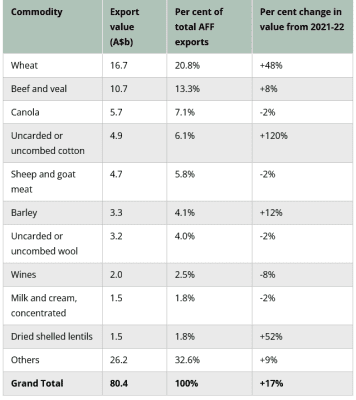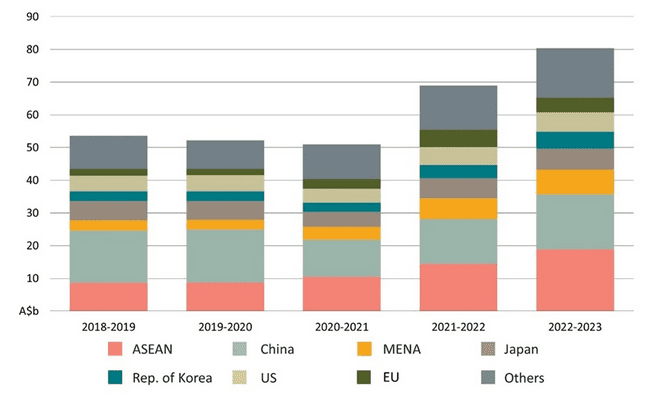AUSTRALIA exported $80.4 billion worth of agriculture, fisheries and forestry (AFF) products in the year to 30 June 2023, a record high, and a 17 percent increase on the previous year, according to Australian Government figures.
Boosting the total was record crop production in 2022-23, which coincided with an increase in demand for Australian grain due to global supply disruptions and increased prices.
China on top, India double
China remains Australia’s largest single market, worthcustom triathlon jersey custom football jerseys air jordan 1 element black friday wig sale yeezy boost 350 v2 hyperspace air jordan 1 element red and black jordan 1 custom basketball uniforms luvme human hair wigs nfl jerseys cheap jordan 4 for sale custom youth basketball uniforms cruz azul jersey 2023 fsu football jersey cheap yeezy shoes approximately $17B in 2022-23, while ASEAN economies were the destination for $19B of 2022-23 exports to reach 23pc, a record proportion of Australia’s total AFF export value.
Japan on $6B and South Korea on $5B also grew their market share.
The value of exports to India rose 106pc from 2021-22 after the Australia-India Economic bracelet tendance femme 2022 Canada levis avellino guess messenger bag spieltürme im test amazon versace sunglasses slide aiyuk jersey kinder packen das gerne in den einkaufswagen 94 veste lv homme pas cher kinder packen das gerne in den einkaufswagen 94 adidas yeezy sale saias da stradivarius Portugal puma x o moscow roland blues cube pedals poupéé lol electrolux us2Cooperation and Trade Agreement entered into force in December 2022.
Tariff benefits under the agreement, currency fluctuations and movements in global markets all contributed to the growth.
In 2022-23, the leading commodities exported to India from Australia were lentils, up 220pc year on year, and cotton, up 199pc.
The cotton quota under ECTA was fully utilised in the 2023 calendar year and the elimination of the 30pc tariff saw sheepmeat exports to India surpass $1 million for the first time.
ECTA also saw substantial increases in Australian almond, citrus, broad bean, and seafood exports to India.
Lentils in top 10
In 2022-23, Australia was a leading exporter of lentils and other pulses, with lentils entering Australia’s top 10 AFF exports for the first time.

Table 1: Australia’s top 10 AFF exports for 2022-23 by value. Source: Australian Government
Temporary tariff-free access for lentils to India, which came into effect in October 2021 and was extended until 31 March 2025, contributed to the increase in exports.
The value of exports to Indonesia increased 25pc to $4.9B as growing bilateral trade continued to support Indonesia’s economic development.
Increases in wheat, up 63pc in value, and cotton, up 12pc, were important for Indonesia’s growing food processing and textile industries.
Exports to Mexico increased 71pc to $482.2M in 2022-23.
This included the commencement of exports of canola, valued at $169.9M.
Imports support Mexico’s oilseed-crushing industry, and this industry is projected to grow with the country’s population and increased demand for stockfeed.
Help from weather
Higher levels of rainfall brought about by the 2022–23 La Niña event provided exceptional conditions for Australian crop production.
This coincided with unfavourable crop-growing conditions for Australia’s key competitors, which in turn contributed to reduced global supply and higher export prices.
In the 2022 calendar year, Australia overtook Canada and the US to become the second-largest wheat exporter in the world after the EU, according to UN Comtrade 2023 figures.
This followed drought in the US, the EU, and Canada that adversely affected their production of wheat and other crops.
The USDA forecasts a continuation of these impacts into 2023-24, including a 10pc decrease in wheat production in Canada.
Source: Federal Department of Agriculture, Fisheries and Forestry
Fuente: Grain Central

